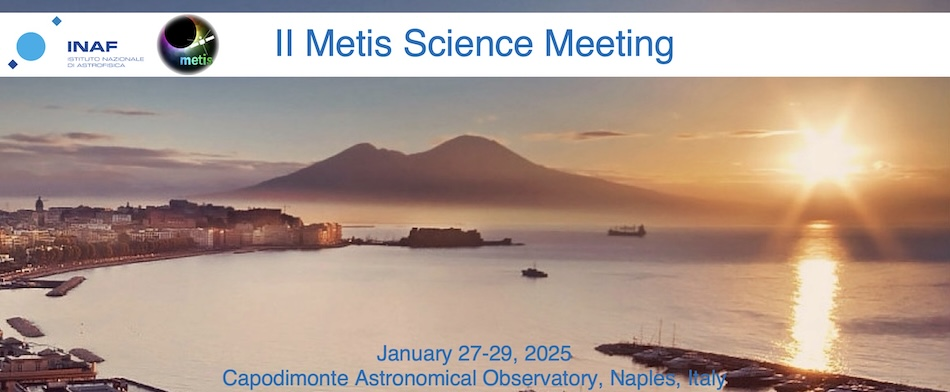Conveners
Metis & Friends: PROBA3 science overview (Invited)
- Andrei Zhukov
Metis & Friends: CODEX Perspectives for Joint Science with Metis, ASPIICS
- Silvano Fineschi (Istituto Nazionale di Astrofisica (INAF))
Metis & Friends: News on MUSE
- Fabio Reale (University of Palermo)
Metis & Friends: The ultimate EUV solar spectrometer: SOLAR-C/EUVST
- Vincenzo Andretta (Istituto Nazionale di Astrofisica (INAF))
Metis & Friends: The European Solar Telescope: Current Status and Scientific Potential (Invited)
- Francesco Berrilli (University of Rome Tor Vergata, Department of Physics)
Metis & Friends: IBIS 2.0 Interferometric BIdimensional Spectrometer 2.0: overview and current status
- Ilaria Ermolli (Istituto Nazionale di Astrofisica (INAF))
Metis & Friends: Radio facilities for Solar and Heliospheric Physics (Invited)
- Alberto Paolo Pellizzoni (Istituto Nazionale di Astrofisica (INAF))
Metis & Friends: HPC for the Italian Solar Physics Community (Invited)
- Paolo Pagano (Istituto Nazionale di Astrofisica (INAF))
Metis & Friends: Machine Learning e Artificial Intelligence applied to Solar and Heliospheric Physics (Invited)
- michele piana (MIDA, dipartimento di matematica, università di genova)
Metis & Friends: ASPIICS-Metis science planning proposals: future possibilities for CME observations
- Emanuele Amato (Istituto Nazionale di Astrofisica (INAF))
Metis & Friends: CODEX planning proposals
- There are no conveners in this block
Metis & Friends: PROBA3-Metis science planning proposals
- There are no conveners in this block
High-performance computing (HPC) has long become a cornerstone for advancing solar physics. The application of HPC in this domain is particularly significant for the understanding of a number of fundamental physics questions when interlaced with realistic boundary and initial conditions or when different physical regimes need to be described simultaneously.
The solar wind, the solar corona,...
The IBIS 2.0 project upgrades the Interferometric BIdimensional Spectrometer, which was operated at the Dunn Solar Telescope of the National Solar Observatory from 2003 to 2019, for installation at the THEMIS telescope of the Teide Observatory. The instrument combines two tunable Fabry-Ṕerot interferometers, narrowband interference filters, a polarimetric unit, fast cameras, and a suitable...
Radio observations can probe and monitor the vertical structure and physical conditions of different layers of the solar atmosphere as a function of the observing frequency. Covering the entire radio range from millimeter to decameter wavelengths, it is possible to explore emission from the temperature minimum (at sub-millimeter waves) to the low corona (at meter waves) with the advantage that...
This talk will illustrate some data- and model-driven computational approaches for data interpretation in heliophysics. Applications will involve flare forecasting using vector magnetograms, space weather prediction using both remote sensing and in-situ data, models for particle acceleration using hard X-ray observations, and desaturation of EUV maps
In 2024, the coronagraphs ASPIICS and CODEX will be launched on the formation flying PROBA-3 ESA mission and on the ISS with a NASA-KASI-INAF mission, respectively. The 150-m separation between the formation-flying Coronagraph and Occulter satellites of PROBA-3 will allow long-duration, eclipse-like imaging of the inner corona, down to heliocentric heights of 1.1 solar radii. Besides the cold...
PROBA-3 is the next ESA mission in the PROBA line of small technology demonstration satellites that was launched on 5 December 2024. It is currently in the commissioning phase. PROBA-3 is a mission dedicated to the in-flight demonstration of precise formation flying techniques and technologies. The PROBA-3 mission will place two small satellites in a highly elliptical orbit around the Earth....
The European Solar Telescope (EST) is a cutting-edge solar observatory that with its multi-wavelength focal plane instruments will study in detail the physical processes that occur in the magnetized plasma of the solar atmosphere and that are at the origin of space weather, and the causes of solar variability. a 4.2-meter primary mirror, the EST will be optimized to study the intricate...
SOLAR-C is the next JAXA-led devoted to the study of the Sun. The overarching science goals of the missions is to further our understanding of how underlying physical processes, acting on small scales, lead to the formation of the outer solar atmosphere and the solar wind, and how the solar atmosphere becomes unstable, releasing the energy that drives solar flares and eruptions.
The main...

